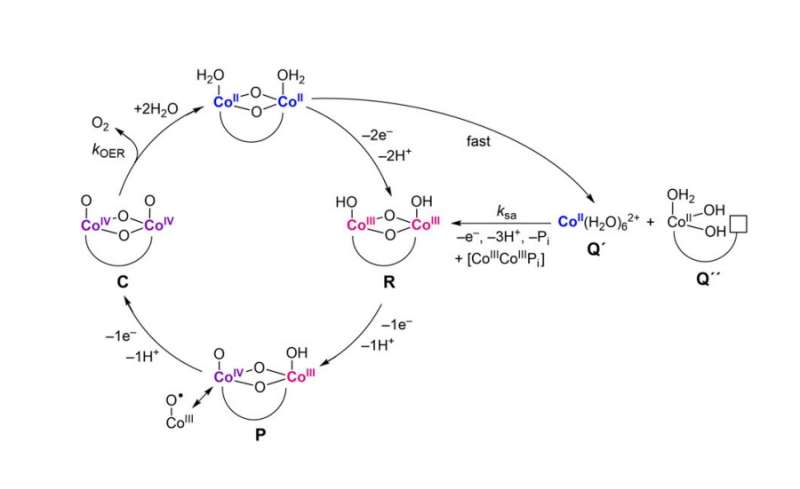September 19, 2017 feature
Self-healing catalysts make it easier to store solar energy with water

(Phys.org)—Currently one of the most efficient ways to store solar energy is to transfer the energy to catalysts that split water into hydrogen and oxygen. Then the hydrogen can either be used as a fuel or later recombined with oxygen to produce water and release electricity when needed.
However, one of the problems with using water to store solar energy is that the catalysts are made of earth-abundant elements (such as manganese, cobalt, and nickel) that corrode in water with a neutral pH. To address this problem, researchers have designed self-healing catalysts that can regenerate themselves in the presence of other elements, such as negatively charged phosphate or borate ions.
One of the remarkable features of the self-healing catalysts is that, as long as they are operating, there is no limit to the number of times that they can heal themselves.
Now in a new paper published in the Proceedings of the National Academy of Sciences, two of the researchers who have developed the self-healing catalyst, Cyrille Costentin at Paris Diderot University and Daniel G. Nocera at Harvard University, have investigated how this process works at a more detailed level.
"This paper provides a quantitative model for self-healing," Nocera told Phys.org. "It actually extends beyond energy and provides a roadmap for the design of any self-healing catalyst. The rule set is self-assembly and catalysis. If the energy input for operation of the catalyst is greater than that for self-assembly, then the catalyst should be self-healing. So the principles developed in this paper are general."
As the researchers show in their work, a catalyst can self-heal if the self-healing process requires less energy than that needed for normal catalyst operation. A simple way to control the self-healing process is to adjust the pH of the solution, since the amount of energy required for these two processes depends on the pH.
The researchers show that there is a critical pH "zone of self-healing" that depends on various factors, in particular the geometry of the water-splitting cell and the phosphate or borate buffer concentration. Fortunately for practical applications, the researchers show that self-healing can occur over a wide range of pH values, including at a neutral pH for typical cell geometries and buffer concentrations, which allows for most natural water sources to be used to store solar energy.
Since much of the future demand for renewable energy is expected to come from low-income, developing countries, the ability to use local natural water sources instead of pure water for storing solar energy will offer a big advantage for implementing the technology cost-effectively and on a large scale. The researchers plan to work toward this goal in the future.
"The next stage is prototyping," Nocera said. "We are using this catalyst in conjunction with CO2 and N2 fixing bacteria (papers from our group in Science in 2016 and PNAS in 2017) to make liquid fuels and fertilizer, renewably (using only air, water, and sunlight as inputs). These prototypes are currently being developed in India at this time."
More information: Cyrille Costentin and Daniel G. Nocera. "Self-healing catalysis in water." Proceedings of the National Academy of Sciences. DOI: 10.1073/pnas.1711836114
Journal information: Proceedings of the National Academy of Sciences , Science
© 2017 Phys.org



















